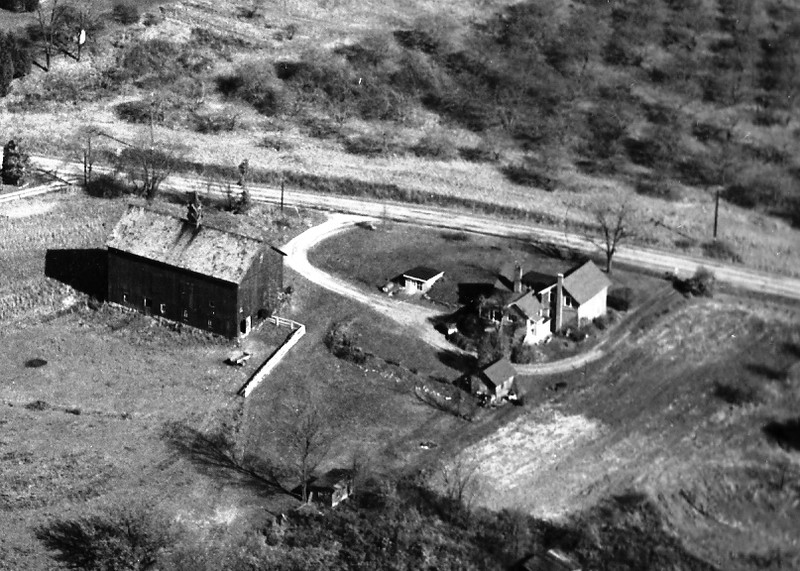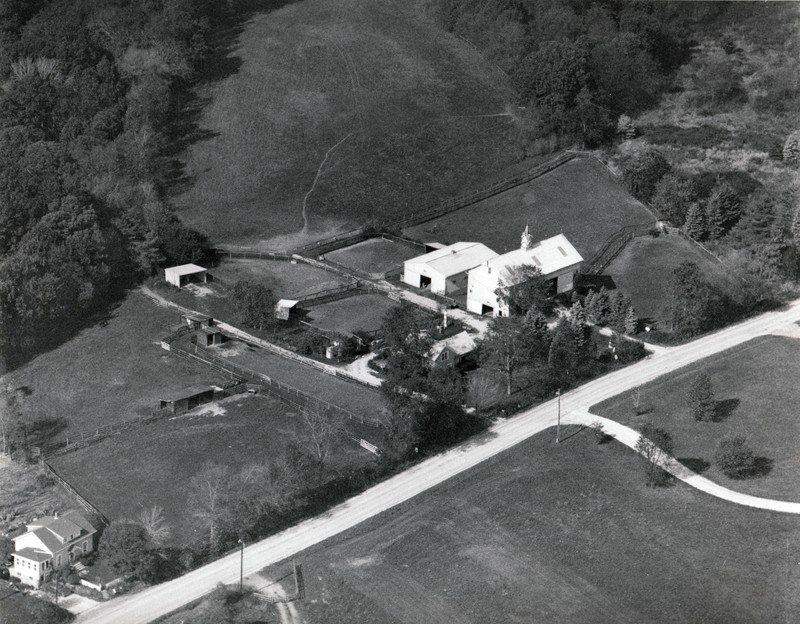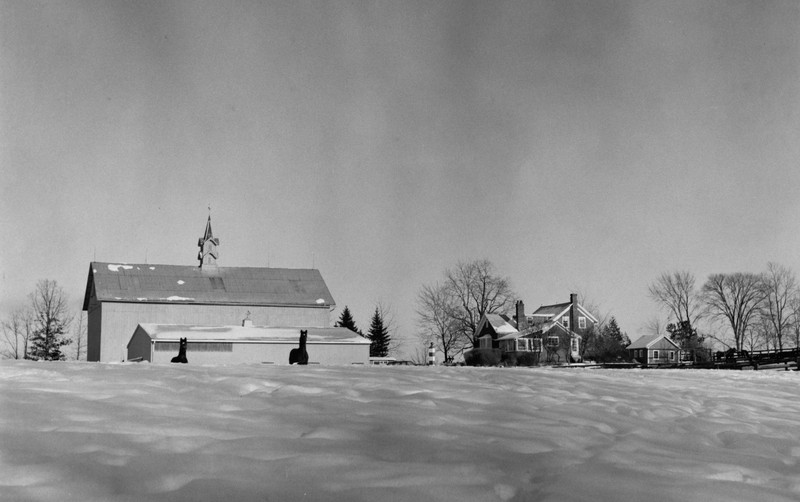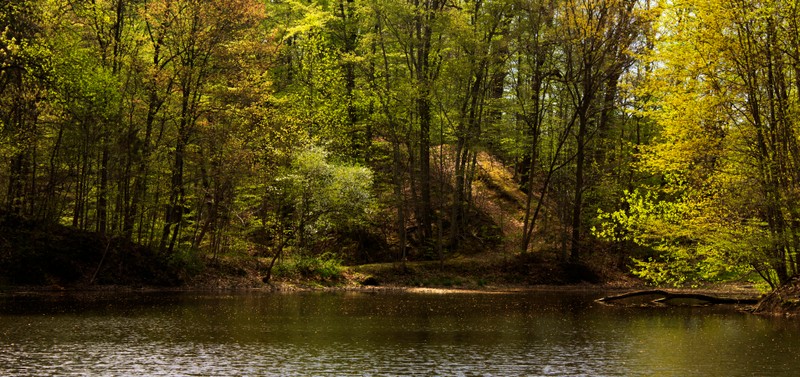Blackacre Farm
Introduction
Text-to-speech Audio
Images
The barn of Blackacre is noteworthy for its double story copula. The barn was built from timber of other barns. Date of construction is unknown. The original barn had a slate room

Aerial view of the farm circa 1956. Note the apple orchard across the road from the farm. The orchard was a part of Quick farm.

Another aerial view of the farm taken in 1968. The Quicks sold their orchards and the trees were removed.

Another view of the barn with horses in the pasture.

Pittenger Pond was created with an earthen dam. The pond was stocked with small mouth bass and a favorite area for the family. The dam has since been removed.

Backstory and Context
Text-to-speech Audio
Law professors, when discussing legal concepts related to real‐estate, may often call a fictional property Blackacre. While an illusion in the minds and hypothetical cases of lawyers, Blackacre Farm was a reality in the Cuyahoga Valley from 1958 to 1985. What began as a summer home for the Pittenger family quickly turned into a permanent residence and a farm that was known for breeding high quality Morgan and thoroughbred horses.
Aldah Jett, born April 1923, earned the nickname Peggy from her father after hearing the show tune, Peg o’ My Heart. Growing up in Akron, Peggy owned a horse and spent much time riding during her youth. Tress Pittenger was born October 1920 in Akron, but moved frequently. A chemist for Firestone, his father was assigned to plants in Canada, California, and, finally, Akron. Tress attended Silver Lake High School and took courses in animal husbandry and land management.
Peggy attended Randolph Macon College for Women and Tress attended Duke University. They met on a blind date during the summer of 1941 when Peggy’s roommate refused to go on a date with her boyfriend until Peggy had a date as well. It was love at first sight; Peggy and Tress began a courtship. The following December, the Japanese attacked Pearl Harbor. As Tress was a senior in college, he decided to complete his degree and then enlist in the Army as an officer. They were married in 1943 after he had completed his basic and officer training. Tress was assigned to the infantry and was stationed in Paris, Tennessee. Toward the end of the war, he was stationed in the Philippines in preparation for the invasion of Japan. After a brief assignment to the occupation forces in Japan, Tress received an honorable discharge and he, Peggy, and their first daughter, Margaret, moved to Cleveland Ohio, where he enrolled in law school at Case Western University.
When Tress completed his degree, the family moved to Akron where he began a practice in law, first as an attorney for a private firm and then for General Tire and Rubber. During that time they had a second daughter, Nancy, and a son, David. In 1957 Peggy and Tress began plans to buy a summer home in the country and eventually found the farm at 4904 Quick Road. They moved into the house during the summer of 1958. Upon returning to the city that fall, the family found that they much preferred life on the farm and thus sold their house on Rosalyn Avenue and move permanently to Quick Road. The farm had not been worked for many years. There was little arable land and few open fields. Neighbors nicknamed the farm “Tumbledown” because of its condition. Indeed, Tress was concerned that the barn should be demolished. Fortunately, a friend of theirs who knew a lot about construction prevailed on Peggy and Tress to preserve the building and invest in its restoration.
At the time, the barn had a slate roof and its distinctive two‐story copula. As a part of the restoration, Tress hired a roofer to install a corrugated steel roof and repair the copula. The main structure of the building, including the hand‐hewn beams and sandstone foundation, were in good condition and needed only to be protected from water. Curiously, many of the larger beams have open slots with no apparent use. The speculation is that these beams were taken from another barn. The upper portion of the barn was used to store hay and grain, and to park farm equipment. The lower level was dedicated to horse stalls. Over time, the stable area was rebuilt. The most extensive renovation occurred in the early 1970s when all the walls for the stalls were replaced and the new barn and connecting corridor were added. The smaller barn had a large court that was use for breeding. In the main barn was a large stall used for foaling and included a closed circuit television that allowed remote viewing of the mare.
After moving to the farm, Peggy and Tress began an aggressive plan to improve the property. Tress bought a small tractor and various equipment including a brush hog, posthole digger, plow, and discs. With this, he began to clear the area immediately around the house to create small paddocks for the horses they were buying for Peggy, Margaret, Nancy, and David to ride. For the paddocks, Tress used split rails to create serpentine fences and also made fences from posts and rails. This was a laborintensive process as he drilled holes into the posts and used an adze to taper the ends of the rails. During the next 25 years, he experimented with different fencing configurations that afforded greater security and safety for the horses and were more durable. He first experimented with woven wire fence. While relatively inexpensive and easy to install, it was a threat to the horses. If caught within the fencing, they were more likely to thrash about and cut themselves. The next generation of fences consisted of posts and three rails. The final generation consisted of a fine woven metal fence where the weave of the metal prevented horses from putting hooves and head through the material. The first horses they acquired were general nondescript horses and ponies that Peggy and the children rode. Unfortunately, the farm soon became a dumping ground for unwanted cats and dogs. All strays were welcomed to the farm and the menagerie began to grow. Added to this were goats that Tress brought. In addition to enjoying having goats as pets, he found that penned goats could quickly clear an area of overgrown vegetation.
While Tress continued his work as a lawyer for General Tire, Peggy began to develop the farm into a horse breeding business. At first, she focused on Morgan horses, a breed unique to America. During the same time, she wrote popular books on raising horses. Her first book, The Backyard Horse, was a general primmer on how to buy, raise, and care for a horse. This book was followed with The Backyard Foal, Reschooling the Thoroughbred, Morgan Horses, and The Wonderful World of Ponies. Each book was lavishly illustrated with many pictures of the farm, the horses, and the Pittenger children. Raising Morgan horses for sale was a niche market. There was a small group of admirers who wished to preserve the breed. As Peggy acquired more horses, she began to purchase thoroughbreds. At first, she bought these horses to be trained for pleasure riding. Her favorite was Nichols W, a race horse with a notably undistinguished record at the track. Peggy bought the gelding from its owner at the Ascot Race Track, a lower quality establishment on State Road in Summit County. In time, Peggy acquired many Morgan and thoroughbred dams, and began an active breeding program. Most of the foals were raised, trained to saddle, and then sold to people who rode for pleasure. Peggy also gave riding lessons. Naming the horses was an interesting exercise. Peggy and Tress decided to name the horses after various legal terms and concepts. The horses had names such as Covenant, Night Season, Replevin, Mandamus, Champerty, and Assumpset. Tress specifically named one of the dams Debt, saying that he wanted something on the farm to come out of debt. Another horse was named Erisa after the Employment Retirement Income Security Act.
Tress continued his improvements of the farm as he cleared larger tracks of land. Soon, he had cleared most of the relatively flat land to be used for large fields or smaller paddocks. He was careful to ensure that the land was well fertilized and seeded with grasses that could sustain grazing. In addition to the field grasses, the horses’ diet was supplemented with locally purchased hay, oats, and various cereal products.
Early in the development of the farm, Tress had an earthen dam placed at the wide part of a ravine, approximately a quarter of a mile behind the house. The dam afforded easier access to the property and created a large lake that the family used for swimming and fishing. He also created small basins in the large fields that would collect rain water and provide the horses with continuous access to water. Around 1965, Tress purchased a small sawmill that could be operated by two men. Working with Philip and Fred Urbank, Tress installed the sawmill in a central, but heavily wooded, part of the farm. Phil and Fred supplied a V‐8 engine and the mechanical expertise to install and maintain the mill. Soon, the farm tractor was joined by a small Caterpillar tractor that was used to pull logs to the mill.
Being mindful of the environmental integrity of the land, Tress arranged for the planting of many white pine, oak, and maple trees on open area that was too hilly for pasture and was overgrown with brambles and other scrub vegetation. He was selective in his harvesting of hardwoods. Specifically, no area was cleared of trees unless the plan was to prepare a new field. He harvested the trees to increase the light cast on the forest floor to support vigorous growth of the smaller trees. At the same time, he planted many evergreen and locust trees that were fast growing and afforded erosion control on hillsides. The Pittengers did not hunt or permit hunting on the property due to concerns about the safety of the horses and the preservation of wild fauna.
With the sawmill, Tress was able to build more substantial fences. The new design included locust posts, as they are extremely resistant to rot, and oak rails. The fences were approximately five feet high with three four‐inch oak rails. Building the fences was a labor‐intensive project, even with a post‐hole digger attached to the tractor.
As the farm operations grew, the Pittengers needed more space. In 1968, they purchased a second farm on Wetmore Road. That property had a small two‐bedroom house, a modest hay barn, and a corn crib/workshop. This farm had been fallow for many years and become overgrown. In 1969, they began a comprehensive building and development program which included clearing more fields, and building a large covered storage area for farm equipment, a modern stable, and an indoor riding arena. In time, the sawmill was moved to the lower portion of the Wetmore property which had once been a gravel pit. They cleared many trails throughout the two properties. Some trails were wide enough to allow the tractors to carry supplies to the various fields and between the two properties. Other trails were horse paths for pleasure riding.
Maintaining the farm was a full‐time job for Peggy and several employees. The house on Wetmore Road was renovated and made available to a farm manager, who tended to the farm and horses. The corn crib/workshop was converted to a Blacksmith shop and apartment. The apartment was given to a laborer who helped with day‐to‐day work.
At any given time, there were various part‐time employees who assisted with cleaning the stables and other sundry tasks. Margaret, Nancy, and David also did farm chores until each decided to attend college and pursue their careers. During the summer, the Pittengers would hire temporary laborers, mostly high school or college students on summer vacation who would help with building fences, making hay, and training the horses to saddle. In addition to selling horses, Blackacre provided livery service for people who wanted to pen their horses at the farm and then ride throughout the property.
The farm’s fortune greatly changed when the Pittengers decided to train two of their horses for racing. Ironically, the horse with the least distinguished pedigree had the greatest success. The dam was For Nothing and the sire was Night Season, both Blackacre stock. Peggy and Tress named the colt Burglary (breaking and entering in the night season).
In 1970, when Burglary was four, the horse was given to a trainer working at Thistledown Race Track in Cleveland. The effort produced quick success as Burglary was an eager runner who quickly proved able in large stakes races. During its career, Burglary ran 67 races with 36 wins, 7 seconds, and 2 thirds. His overall earnings was $267,000. In 1972, Burglary was named Ohio Horse of the Year. Delighted sports writers thought themselves clever with headlines such as “Burglary Runs Away with Purse.” The success of Burglary caused Peggy and Tress to shift the breeding emphasis of the farm. Over time, they sold the Morgan horse stock and concentrated on raising race horses. Each year, Peggy would attend the horse sales at Keenland and would occasionally purchase a new dam to expand the farm’s breeding stock. By the late 1970s, the farm was extremely active in selling and racing horses. The farm was now a self‐sustaining operation.
That Blackacre was successful owes to the confluence of hard work and dogged persistence, willingness to take risks, a supportive community, and the luck of good fortune. Farming, especially animal husbandry, is an all consuming activity. Horses require extensive care including daily feedings, attention to their overall health, cleaning of the stables, and maintenance of pastures and paddocks. Horses are also prone to various ailments that require constant vigilance. The typical day on the farm began with Peggy rising around 5:30 a.m. to feed the horses closest to the farm house and ensure that all were well. After breakfast, she and her employees would move horses from the barns to the paddocks. Next, she would ride to various distant fields to inspect and feed the horses. There were also stalls to be cleaned and various other daily chores. The afternoon was spent handling correspondence and attending to long‐term planning. When Tress returned from work, he did various maintenance tasks. On weekends, he restocked outpost fields with grain and hay, built or repaired fences, and attended to financial matters.
In essence, each brought complimentary skills and talents to the operation of the farm. Tress contributed his business acumen, overseeing the financial management of the farm. He was a skillful carpenter and able with the chainsaw, bulldozer, and lumber mill. Working at General Tire, he had ready access to engineers who would advise him when he decided to build bridges over large streams or build retaining walls. Similarly, he consulted the county extension agent regarding the care of open fields. This advice was not always sound as the agent recommended planting multiflora rose as a “living fence.” While the use of the plant was recommended from the 1930s to 1960s, it is now considered a nuisance and invasive plant. Peggy had a deep knowledge of horse care owing to her continuous reading of books and journals and her conversations with veterinarians and other horse breeders.
Farms exist in communities and there was an attitude of collaboration among local residents. During the summer, neighbors would help each other bale and store hay. Neighbors who helped maintain the sawmill could then use it to mill logs for their own use. Whenever someone was ill, there was a neighbor who would help with chores.
Finally, breeding horses for races is a risky business. A friend once asked how much Tress would bet on a race in which his horse was running and was surprised to learn that the wager was typically a modest $20. He noted that he had already gambled thousands of dollars in the care and training of the horse and only hoped that the stakes of the race would offset the expenses. Indeed, few in the horse‐raising business become rich. Fortunately, Blackacre was successful at producing a number of stakes winners and attracting horse people interested in buying for racing or pleasure riding.
In 1985, Tress retired from General Tire, which had been renamed GenCorp after the tire production portion of the corporation was sold. It was then that the National Park Service purchased the farm during the establishment of Cuyahoga Valley National Park. Peggy and Tress moved Blackacre Farm to Palmyra, Virginia. Virginia had recently legalized pari‐mutuel racing and they hoped horse racing would become popular in the state. After 10 years they sold the farm and returned to Akron. Peggy died in 2003 and Tress died in 2005. They are buried in Rosehill Cemetery.
Cite This Entry
Pittenger, David. "Blackacre Farm." Clio: Your Guide to History. August 26, 2015. Accessed April 3, 2025. https://theclio.com/entry/17986

